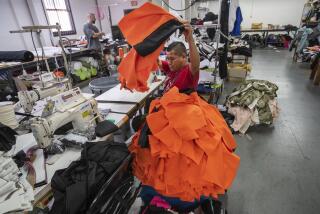Durable Goods Orders Up 3.8% During August
- Share via
WASHINGTON — Orders to U.S. factories for “big ticket” durable goods accelerated 3.8% last month, riding brisk automobile sales to the biggest gain since December, the government said Tuesday.
But some economists questioned whether that volatile manufacturing sector could keep up the pace in the face of a slowing economy and said the first decline in unfilled orders since February, 1987, was a sign of weakness.
The Commerce Department said demand for durable goods, items expected to last more than three years, totaled a seasonally adjusted $126.7 billion after declining 2.5% in July. The July figure was revised from a 1.9% drop reported earlier.
Decline in Aircraft
After rising 7.4% in December, durable goods orders have seesawed this year, rising in March, April, June and August and falling in January, February, May and July.
Orders in the transportation sector last month rose 6.3% to $36.3 billion as a big increase for motor vehicles offset a decline in aircraft. Transportation orders had risen 1.8% in July.
Even without the transportation sector, durable goods orders were up 2.7% after falling 4% the previous month.
“I doubt that the automobile pace will continue,” said Cynthia Latta, an economist with DRI-McGraw-Hill Inc., a Lexington, Mass., business forecasting organization.
She noted that some auto makers are reducing their production schedules and offering rebates and subsidized financing to spur sales of 1990 models even before they get to the showroom.
Both Latta and Robert Brusca, chief financial economist for Nikko Securities Co. in New York, pointed to the 0.3% decline in unfilled orders as evidence of weakness.
“The backlog of orders declined everywhere except transportation and that’s only because of autos,” Brusca said. “That decline says demand is slackening.”
The Federal Reserve, which raised interest rates for 14 months to slow the economy and control inflation, began in June to nudge rates down. Durable goods orders are particularly sensitive to interest rates because consumers and businesses often have to borrow to finance such purchases.
Nevertheless, analysts said Tuesday’s report would not spur the Fed to further action.
“For now, it probably tends to keep the Fed on hold,” Brusca said.
Latta agreed, saying: “It can’t tune policy to bail out the durable goods manufacturers; it has to look at the whole economy.”
Orders for non-electrical machinery, which includes computers and a wide variety of industrial equipment, increased 9.2% to $22.8 billion, but that was a rebound from a 10.4% decline in July.
More to Read
Inside the business of entertainment
The Wide Shot brings you news, analysis and insights on everything from streaming wars to production — and what it all means for the future.
You may occasionally receive promotional content from the Los Angeles Times.










